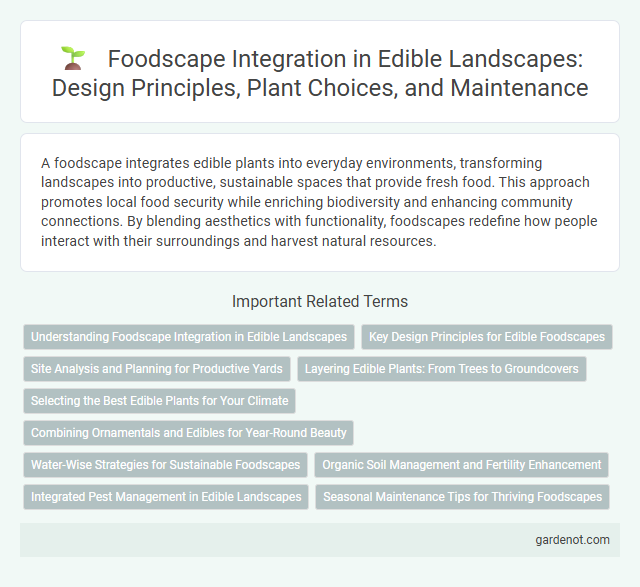A foodscape integrates edible plants into everyday environments, transforming landscapes into productive, sustainable spaces that provide fresh food. This approach promotes local food security while enriching biodiversity and enhancing community connections. By blending aesthetics with functionality, foodscapes redefine how people interact with their surroundings and harvest natural resources.
Understanding Foodscape Integration in Edible Landscapes
Foodscape integration in edible landscapes involves blending food-producing plants seamlessly into urban and residential environments to enhance sustainability and food security. This approach prioritizes diverse plant selection, spatial design, and ecosystem services to create multifunctional spaces that support biodiversity and community well-being. Effective foodscape strategies optimize resource use and promote local food production while maintaining aesthetic and ecological balance.
Key Design Principles for Edible Foodscapes
Key design principles for edible foodscapes emphasize the integration of diverse, nutrient-rich plant species to maximize both aesthetics and food production within urban or residential settings. Incorporating native and climate-adapted plants ensures sustainability while promoting biodiversity and resilience against pests and diseases. Strategic layering of plants by height, root depth, and growing season optimizes space and continuous yield, fostering a functional and visually appealing edible landscape.
Site Analysis and Planning for Productive Yards
Site analysis for foodscapes involves assessing soil quality, sunlight exposure, water availability, and microclimates to optimize plant growth in productive yards. Planning integrates zoning for edible plants, companion planting, and efficient irrigation systems to maximize yield and sustainability. Strategic layout enhances biodiversity, supports pollinators, and reduces maintenance while ensuring year-round food production.
Layering Edible Plants: From Trees to Groundcovers
Layering edible plants in a foodscape maximizes space, biodiversity, and harvest yield by incorporating canopy trees, understory shrubs, herbaceous perennials, and groundcovers. Fruit and nut trees form the upper layer, while berry bushes and culinary herbs fill the middle strata, with nutrient-rich greens and root vegetables thriving close to the soil. This stratified planting method enhances ecological resilience, improves soil health, and supports year-round food production in sustainable edible landscapes.
Selecting the Best Edible Plants for Your Climate
Choosing the best edible plants for your climate involves analyzing local temperature ranges, soil types, and rainfall patterns to ensure optimal growth and yield. Native and climate-adapted species, such as drought-tolerant herbs or cold-hardy vegetables, enhance sustainability and reduce maintenance in your foodscape. Incorporating diverse plant varieties that thrive in your specific environmental conditions promotes a resilient and productive edible landscape.
Combining Ornamentals and Edibles for Year-Round Beauty
Integrating a foodscape by combining ornamentals and edibles creates a visually stunning and productive garden that thrives throughout the year. Perennial herbs like rosemary and thyme provide evergreen structure, while vegetables such as kale and chard add vibrant color and nutrition during cooler months. Strategic planting of flowering fruit trees alongside seasonal annuals ensures continuous aesthetic appeal and harvest from spring through autumn.
Water-Wise Strategies for Sustainable Foodscapes
Water-wise strategies in sustainable foodscapes prioritize drought-resistant plant species, efficient irrigation techniques such as drip systems, and rainwater harvesting to conserve water resources. Incorporating native plants adapted to local climates minimizes water demand while maintaining soil health and biodiversity. Integrating mulch and soil amendments enhances moisture retention, reducing the need for frequent watering and supporting resilient edible landscapes.
Organic Soil Management and Fertility Enhancement
Organic soil management in edible landscapes prioritizes natural inputs such as compost, green manure, and cover crops to enhance soil fertility and structure. Maintaining a balanced soil microbiome through organic amendments boosts nutrient cycling, water retention, and plant resilience. Integrating crop rotation and mulching further supports long-term soil health, promoting sustainable productivity in foodscapes.
Integrated Pest Management in Edible Landscapes
Integrated Pest Management (IPM) in edible landscapes emphasizes sustainable strategies such as biological control, habitat manipulation, and the use of resistant plant varieties to minimize chemical pesticide reliance. Foodscape design incorporates companion planting and crop diversity to naturally deter pests while promoting beneficial insect populations like ladybugs and parasitic wasps. Implementing IPM techniques within foodscapes ensures healthier plants, reduces environmental impact, and supports long-term productivity in edible garden ecosystems.
Seasonal Maintenance Tips for Thriving Foodscapes
Seasonal maintenance is crucial for a thriving foodscape, emphasizing soil enrichment with organic compost during spring to boost plant growth. Regular pruning of perennial herbs and removal of spent crops in summer prevents disease and encourages new yields. Fall cleanup includes mulching and planting cover crops to improve soil health and protect against winter erosion.
Foodscape Infographic

 gardenot.com
gardenot.com